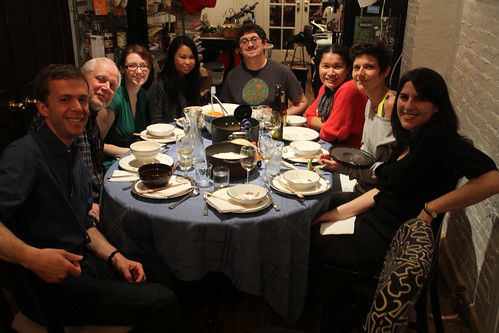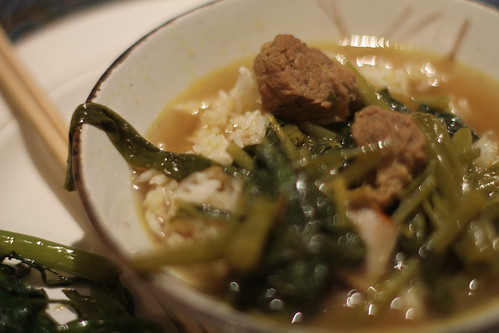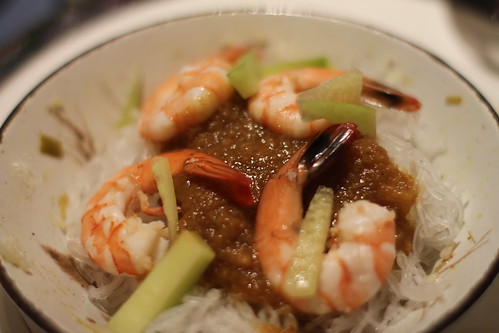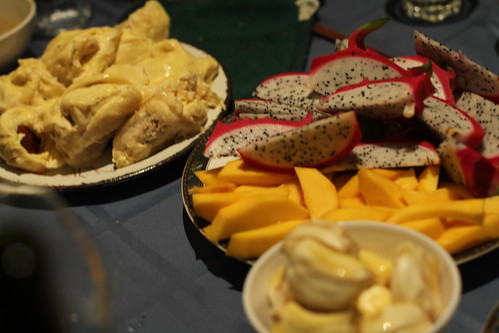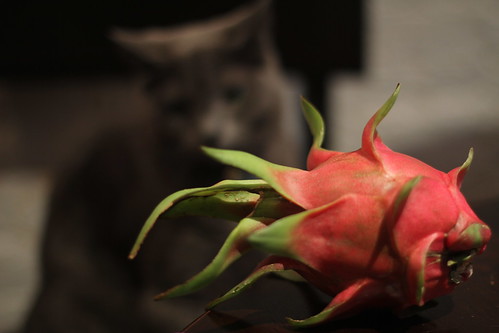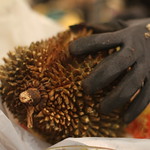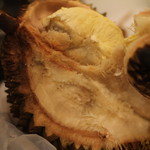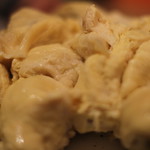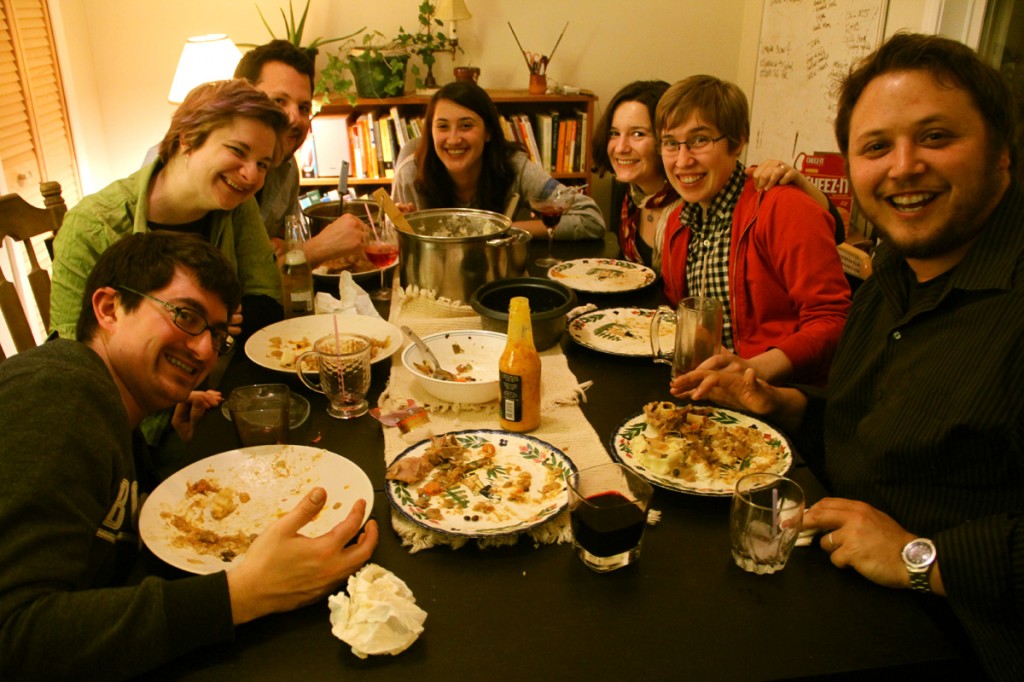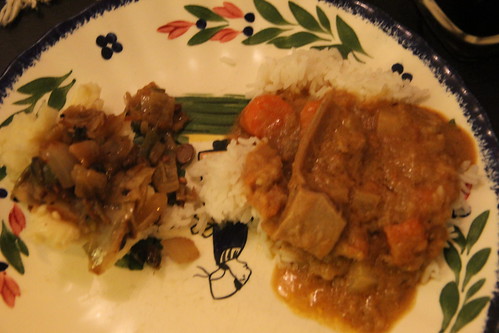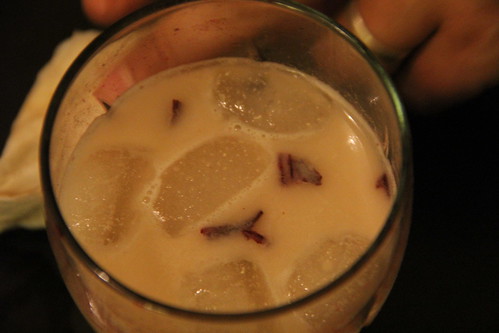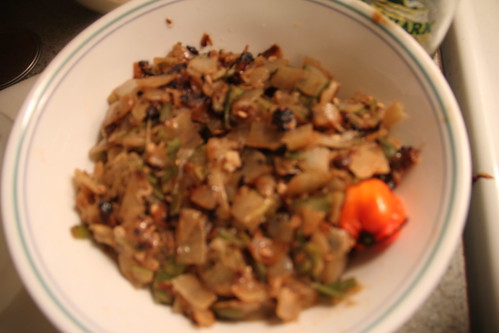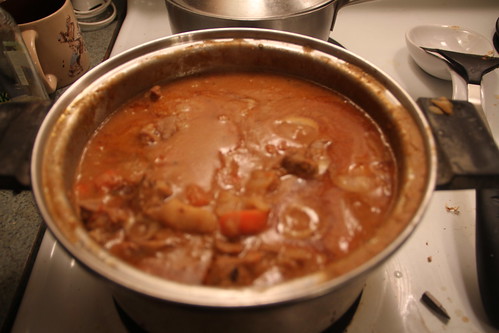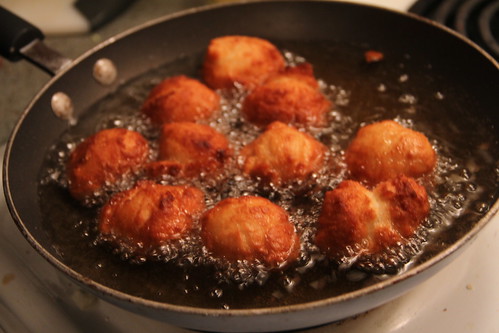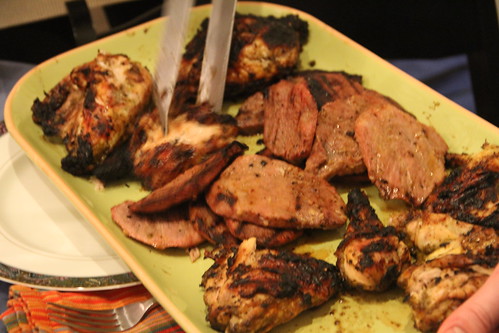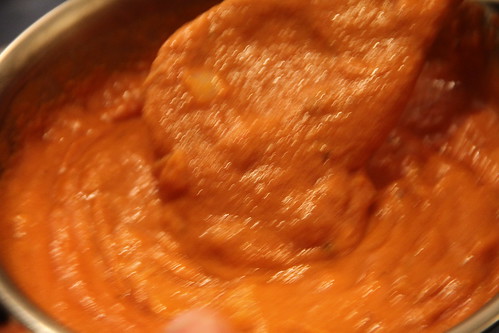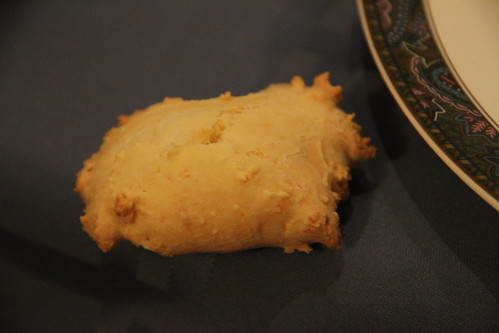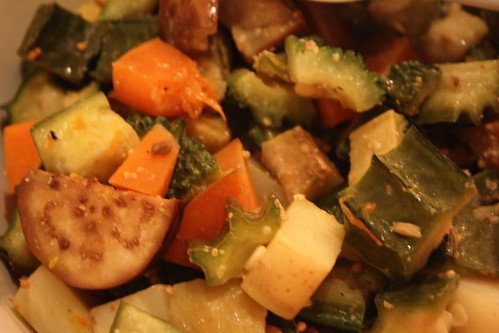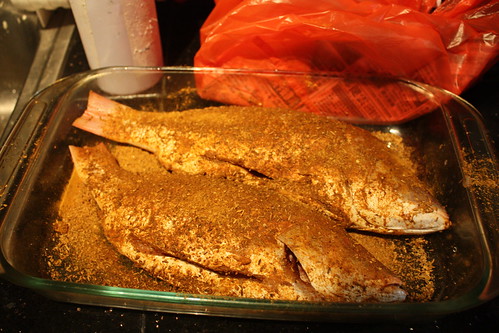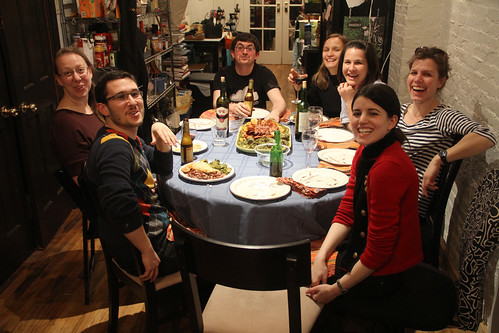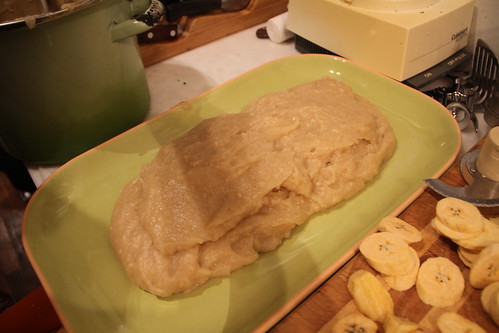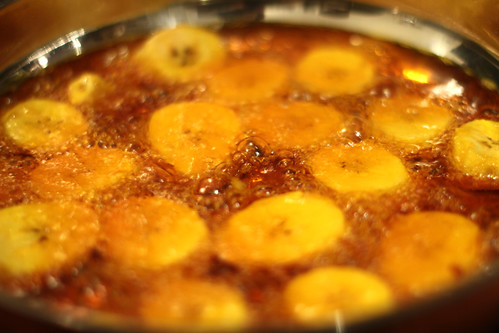Laura is Canadian, Monday was her birthday, and we're at the beginning of the C's. That's a recipe for a Canadian blowout party! For eight hours we fried, drank, and sang our way through the Great White North. We went through the better part of twenty pounds of potatoes, five pounds of cheese curds, a gallon of gravy, and every last bottle of wine in the house. Let's be honest, this isn't a collection of dishes you'd likely find on a table in Halifax or Edmonton — by and large they eat roughly the same up there as we do down here, perhaps with more ketchup squirted on top. But by dint of history, marketing, and circumstance, there are indeed some dishes that are classically Canuck. Not surprisingly given the universal link between cultural identity and cuisine, many of the dishes come from the French Canadians, who have had a complex identity with and within Canada ever since becoming subjects of the British Crown after the French and Indian War in the eighteenth century.
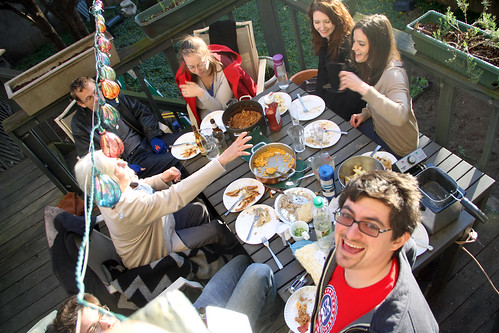
We had about thirty people come and go throughout the afternoon and evening — including Laura's mom Eileen and sister Jen, who were visiting! It was a lovely day, and our first meal of the year outside. This time we took a break from fundraising for the World Food Program, and instead asked guests to support Laura's fundraising ride in the upcoming Five Boro Bike Tour benefitting CAMFED, an amazing organization that directly supports girls' education in sub-Saharan Africa. Please consider donating!
Poutine | Fries with cheese curds and gravy | Recipe

In Quebecois French, une poutine is "a mess." Never has a food been given a more appropriate name! Interestingly, the dish was only invented about 50 years ago, but has become so widespread that it topped a survey of Canadians as being their national dish. Anyway, French fries topped with cheese curds and smothered with gravy is just as disgustingly awesome as it sounds. Let's deconstruct it:
- Fries: Unlike Belgian fries, which I made with yukon gold potatoes to replicate the lower-starch bintje variety, a classic North American fry is made with a starchier potato like good ol' Idaho russets. (Though in Canada, Prince Edward Island is the famous spud-grower). I left the potatoes unpeeled 'cause I prefer them that way, soaked them in ice water for a half hour after slicing to draw out some of the starch, drained them and let them air-dry, fried for about 8 minutes at 325° to cook them through, let them sit for about 20 more minutes, and then finally crisped the for a few minutes at 370°. It's a lot of steps, but makes for a potato that's soft on the inside and crispy on the outside.
- Gravy: To make chicken stock, I swear by the technique in Cooks Illustrated's The New Best Recipe, which eschews carrots and other aromatics and just has you concentrate on drawing as much flavor out of the meat as possible. This one I made with a seven-pound roaster (minus the breast, which I actually simmered as the stock was cooking and used for sandwiches). Making the gravy was super-simple, just throw in some butter and flour and whisk it good. (I also made a vegetarian version using a boxed broth.)
- Cheese curds: These little lumps of joy taste like medium-mild cheddar, but due to their higher moisture content they melt fantastically. When they're super-fresh they squeak when you bite into them, but cheese curd options are limited in NYC, and even though I got the freshest ones I could find at Saxelby Cheesemongers, we didn't get that experience. But oh well.
Tourtière | Spiced pork pie | Recipe
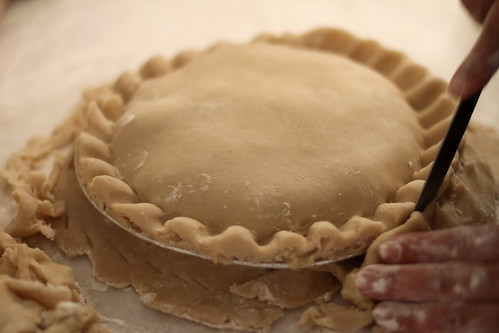
The tourte is a long-extinct pigeon that was once the filling of this pie, traditionally served by French Canadians on Christmas Eve. The place is now taken by pork, but the combination of spices such as sage, thyme, and cloves give a beautifully comforting and old-timey flavor.
Pastry has always been my cooking weak spot, and I've been steadily improving, but I gladly put this job in Eileen's expert hands as you see above. Her expertise is not only in technique, but also in recipes. Rather than what's given in the linked recipe, the pastry we used for both the pie and the butter tarts is as follows. It's enough for two whole pies (or 24 butter tarts):
5 1/2 cups of flour 1/2 tsp salt Cut in 2 cups of Crisco Mix with 1 egg, 2 tsp vinegar and enough cold water to make 1 cup total of liquid
The dough holds up nicely when you work it, especially if you refrigerate it for a while. It's also delightfully flaky in that Crisco way.
Kraft Dinner
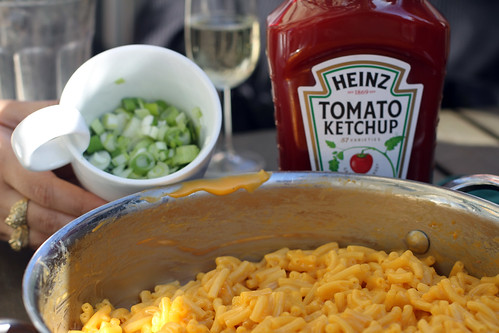
We wouldn't have to eat Kraft Dinner But we would eat Kraft Dinner Of course we would, we'd just eat more. And buy really expensive ketchups with it. That's right, all the fanciest... Dijon ketchups! Mmm. — If I Had $1,000,000 Dollars, Barenaked Ladies
Sure, the day-glo yellow of Kraft Mac & Cheese was a staple for many of us who grew up in the States. I can't even look at my parents' six-quart saucepan without smelling the tang of powdered cheese. But only Canadians sing about this easy-to-prepare boxed meal, or assign it a rarified two-letter nickname — KD. They are, far and away, the world's most avid consumers of the blue boxes, so along with time-consuming dishes of distinctive patrimony, Raven whipped up a big batch.
I really wish someone had told ten-year-old me that mac and cheese goes so well with ketchup. I guess the Barenaked Ladies tried to, but I didn't catch the message. According to our friend from Calgary, Ophira Eisenberg, KD with ketchup and scallions is known as "Skiiers' Delight," and that's exactly how we enjoyed it.
Fèves au lard | Maple baked beans | Recipe
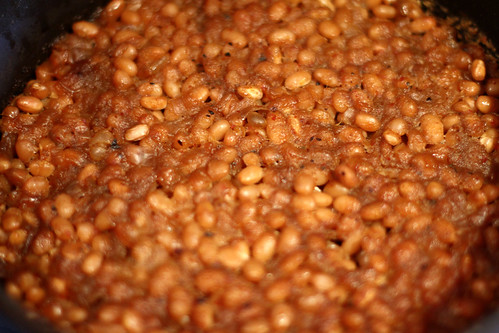
Truth be told, finding truly Canadian dishes was tough, and everything I was finding was so fatty and unhealthy. I begged Laura and her mom for advice on a vegetable dish, but none was forthcoming. What joy when I found this dish for baked beans made with maple syrup...they're not veggies, but they are healthier! In context of the meal, the pound of salt pork that seasoned the double-batch of beans was a mere condiment for healthsome beans. Whether you make it with the pork, or try the smoky vegan version, you won't be disappointed. It takes a long time, but with the firmness of the beans and the rich and subtle sweetness of the sauce that coats them, you'll realize that canned baked beans just pale in comparison. If there's one dish that I learned from this meal that I'd make again, it was these!
Caesar | Bloody mary with Clamato | Recipe
Who knows why Mott's decided to market a tomato juice with a bit of clam flavoring, but luckily for them, a bartender in Calgary discovered Clamato and fixed a bloody mary-type drink with it, garnished with celery salt, and the rest is history. This drink has a firm lock on the Canadian cocktail pantheon but is virtually unknown elsewhere. Luckily, you can still find Clamato in the U.S., but with Spanish labeling, since it's what you mix with beer and hot sauce for a chelada.
Shotski
 image credit: Raven Keller
image credit: Raven Keller
Laura and I encountered the shotski at her cousin Ryan's wedding up in Whistler. Glue shot glasses to a ski, fill with shots of choice, get friends together, kneel down, put glasses to your lips, and toss it back on the count of three. I couldn't find Sortilege, so I made it myself by shaking Canadian Club whiskey with maple syrup (in roughly a 4:1 ratio) with ice and straining. The shotski was fun, and the drink was tasty. And now we have a six foot board with shot glasses emblazoned with Canadiana that we've got to store somewhere!
Butter tarts | Recipe

When I proposed to Laura, I placed the ring in a butter tart. When word traveled north of this deed, her aunts, uncles, and cousins were instantly inclined to like me. That's how important these gooey, crispy, addictive desserts are to her, her extended family, and millions of Canadians. Like the Caesar, this treat is way popular in Canada, served in diners and Tim Horton's and houses across the land, but barely seems to have made it down south. This heavenly combination of raisins, corn syrup, brown sugar, butter, and pastry crust is overdue to invade! (The closest we've found is the Momofuku crack pie, but it truly pales in comparison.)
Ice creams | Recipes: Maple, blueberry


With all the cold that comes from living up north, you'd think Canadians wouldn't be into frozen desserts. But you'd be wrong! Turns out Canada has the sixth-highest per capita ice cream consumption, and I like making ice cream, so the deal was sealed.
The blueberry ice cream was made from wild berries picked in northern Quebec, which conveniently enough are available frozen at Trader Joe's. And oh, how tasty they are: they're really small, but bursting with a depth of flavor that's just lacking from the larger, commercially grown ones. For this I simmered the frozen berries with some lemonade (ha, it's what I had on hand) until it made a lovely thick sauce, and then mixed that in with a standard custard ice cream base. The maple was similar, but a lot easier: just replace most of the sugar with maple syrup, and make ice cream as normal. Both were fantastic; the latter is especially good scooped on top of a butter tart.
To go along with everything, Laura made up a list of Canadian musicians. Take a look, you'll be amazed at just how many great musicians come from up there. Probably has something to do with content laws that require one quarter of all music on the radio to be from Canadian artists.
Phew! That was a lot of fun, and quite a wipeout. Learned a few things about hosting for such a big crowd. One thing we did really right was making it over a long time period, so people could come and go and we were never too packed. A lesson for next time is to not make something that requires short-order prep like poutine; that occupied a lot of my time and had me on my feet for hours on end, although we did have the deep fryer set up where I could hang out.
Thirty meals down, 164 to go. Next up, Cameroon!
Photos by Laura Hadden, who refuses to disclose how many butter tarts she ate.

